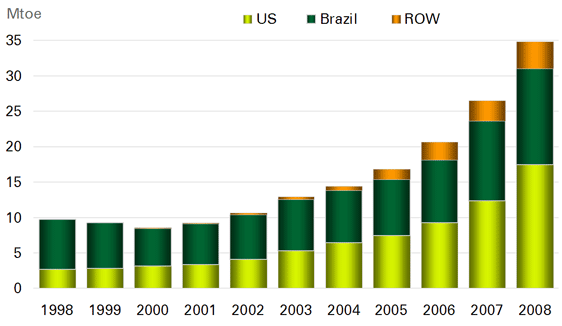Team:UNICAMP-Brazil/Yeastguard/Why
From 2009.igem.org
| Line 9: | Line 9: | ||
<p style="text-align:justify;font-size:0.9em;">Figure 1: This bar chart shows global fuel ethanol production in million tons oil equivalent (Mtoe) from 1998 to 2008. Brazil, US and Other are depicted. The US has shown the greatest increase in ethanol production from 2.64 Mtoe in 1998 to 17.46 in 2008. Brazil’s ethanol production has increased from 7.05 in 1998 Mtoe to 13.55 Mtoe in 2008. Other has grown form 0 to 3.79 Mtoe over the period (adapted from “Statistical Review of World Energy 2009”).</p> | <p style="text-align:justify;font-size:0.9em;">Figure 1: This bar chart shows global fuel ethanol production in million tons oil equivalent (Mtoe) from 1998 to 2008. Brazil, US and Other are depicted. The US has shown the greatest increase in ethanol production from 2.64 Mtoe in 1998 to 17.46 in 2008. Brazil’s ethanol production has increased from 7.05 in 1998 Mtoe to 13.55 Mtoe in 2008. Other has grown form 0 to 3.79 Mtoe over the period (adapted from “Statistical Review of World Energy 2009”).</p> | ||
| + | |||
<p style=”text-align:justify;”>Although US is still the major producer of ethanol, Brazilian´s production is also increasing and presents a big advantage compared to the American maize derivate: its relative inexpensive production costs. As shown in figure 2, the increase in Brazilian production is followed by a decrease in its production costs, allowing ethanol to be competitive with gasoline in our intern market (7).</p> | <p style=”text-align:justify;”>Although US is still the major producer of ethanol, Brazilian´s production is also increasing and presents a big advantage compared to the American maize derivate: its relative inexpensive production costs. As shown in figure 2, the increase in Brazilian production is followed by a decrease in its production costs, allowing ethanol to be competitive with gasoline in our intern market (7).</p> | ||
| Line 32: | Line 33: | ||
==How can Lactobacillus contamination be controlled?== | ==How can Lactobacillus contamination be controlled?== | ||
| - | <p style=”text-align:justify;”>It has been reported that various agents, including antiseptics such as sulfite, hydrogen peroxide, 3, 4, 4-trichlorocarbanilide, and urea hydrogen peroxide and antibiotics such as penicillin, tetracycline, monensin, and virginiamycin are effective in preventing bacterial contamination. Penicillin and virginiamycin are currently used commercially to prevent contamination in the bioethanol production process, and some facilities use these antibiotics prophylactically (9). Bacillus sp. and Lactobacillus sp. isolated from Brazilian industrial fermentation unitswere shown to be susceptible to penicillin and the ionophore antibiotic monensin (8). However, it is particularly important to prevent bacterial contaminants during bioethanol production without using antibiotics, because all the selective pressure that the use os antibiotics can cause. Moreover, the use of these compounds increases the costs of the production. This way, the idea of our project remains on a possible control for contaminants without the addition of any extra compound on the fermentation vat.</p> | + | <p style=”text-align:justify;”>It has been reported that various agents, including antiseptics such as sulfite, hydrogen peroxide, 3, 4, 4-trichlorocarbanilide, and urea hydrogen peroxide and antibiotics such as penicillin, tetracycline, monensin, and virginiamycin are effective in preventing bacterial contamination. Penicillin and virginiamycin are currently used commercially to prevent contamination in the bioethanol production process, and some facilities use these antibiotics prophylactically (9). ''Bacillus'' sp. and ''Lactobacillus'' sp. isolated from Brazilian industrial fermentation unitswere shown to be susceptible to penicillin and the ionophore antibiotic monensin (8). However, it is particularly important to prevent bacterial contaminants during bioethanol production without using antibiotics, because all the selective pressure that the use os antibiotics can cause. Moreover, the use of these compounds increases the costs of the production. This way, the idea of our project remains on a possible control for contaminants without the addition of any extra compound on the fermentation vat.</p> |
==Our Project: How to control Lactobacillus contamination on fermentation vats?== | ==Our Project: How to control Lactobacillus contamination on fermentation vats?== | ||
| - | <p style=”text-align:justify;”>Based on the problems caused by lactobacilli contamination on fermentation vats, we developed and idea to try to solve it. We decided to engineer strains of S. cerevisiae and make them able to sense the presence of contaminants and destroy them. This yeasts are going to work as | + | <p style=”text-align:justify;”>Based on the problems caused by lactobacilli contamination on fermentation vats, we developed and idea to try to solve it. We decided to engineer strains of S. cerevisiae and make them able to sense the presence of contaminants and destroy them. This yeasts are going to work as "yeastguards" of the vats, allowing the fermentation to occur without lactobacilli contamination. The elimination of this kind of contamination would decrease the losses in production, which would be extremely helpful to our country economy.</p> |
Revision as of 18:25, 21 October 2009
| ||||||||||||||||||||||||||||||||||
 "
"















